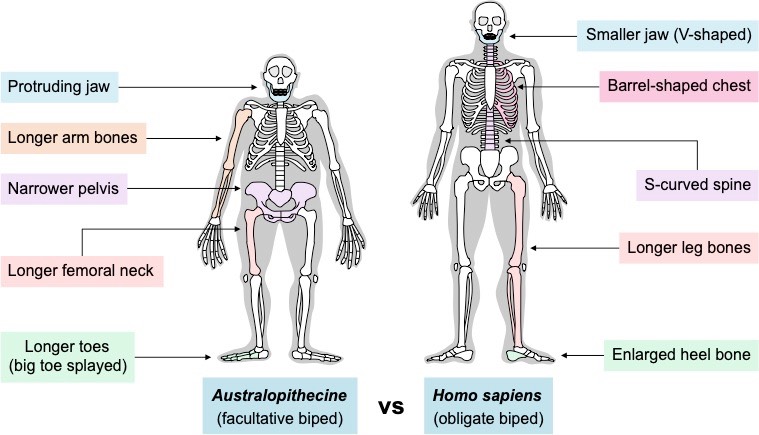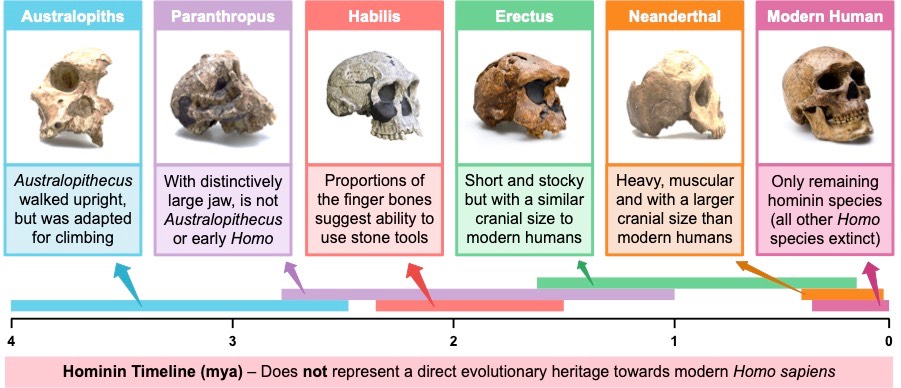Key Knowledge:
|
Hominin evolution includes all species which have evolved since the human lineage split off from the one that gave rise to the great apes
- Around 8 million years ago, a global cooling and drying trend created a climate change in Africa, splitting the hominin sub-family
- One population remained in the wet rainforests of western Africa and gave rise to modern chimpanzees (genus = Pan)
- The other population adapted to the increasingly open, dry habitats of eastern Africa, giving rise to modern humans (genus = Homo)
The population of hominins that occupied the dry savannah habitats evolved many characteristics to suit these environmental conditions
- They developed a capacity to walk upright (bipedalism), improving visual awareness and freeing up hands for tool manipulation
- This lead to dietary changes that increased brain development and also resulted in greater mobility (more geographic spread)
Hominin Evolutionary Trends
The earliest hominins included the ape-like Australopithecines, which were superseded by the genus Homo (includes all humans)
- By comparing different Australopithecine and Homo fossils, evolutionary changes can be identified
The major evolutionary trends seen in hominins involve changes in brain size (greater intelligence) and limb structure (bipedalism)
- More downward facing foramen magnum (caused by a transition to bipedalism)
- S-shaped curvature of the spine (an artifact of an increasingly erect posture)
- Lower and broader pelvis (bipedalism has changed the hominin birthing patterns and behaviours)
- Change in relative lengths of arm and leg bones (arms have become relatively shorter and legs longer due to walking upright)
- Increased size of heel bone and alignment of big toe (changes in feet to become greater weight-bearing structures)
- Flatter faces, with reduced brow ridges and jaw protrusion (head is no longer the most anterior part of the body)
- Larger cranial capacity with increased brain size and greater encephalisation (greater intellectual prowess)
- Smaller teeth and jaws more V-shaped (reflecting changing dietary requirements with less emphasis on tough vegetation)
- Marked reduction in body hair (improved hunting and cultural practices have lead to the development of warm clothing)
- Shift in muscle groups (particularly the gluteal and hamstring groups, in order to accommodate new mode of locomotion)

Human Fossil Record
There is significant and continuous debate concerning the exact timeline for human evolution as the fossil record is incomplete
- Very few hominin fossils have been discovered, so palaeoanthropology is an inductive science based on limited data
- Also, individual fossils may not be representative of actual species (e.g. H. floresiensis may be a dwarf member of an existing species)
Furthermore, at various stages of hominin evolution, several species may have co-existed and potentially interbred with one another
- This challenges the classification of certain fossils as distinctive species (as different species are not supposed to be able to interbreed)
- It also suggests that the extinction of some species may have resulted from a gradual interbreeding with others (i.e. species integration)
One example of new evidence challenging pre-existing classification schemes is the discovery of fossils in the Denisova cave (Russia)
- Excavations uncovered fossils of three distinct species – Denisovans, Neanderthals (H. neanderthalensis) and humans (H. sapiens)
- DNA analysis indicates that interbreeding occurred between the populations (e.g. Neanderthal DNA was found in the Denisovan fossil)
This evidence of interbreeding is further supported by the analysis of modern human sequences:
- European and Asian populations share 1–4% of their DNA with Neanderthals
- Polynesians (including Australian Aboriginals) carry roughly 3–5% Denisovan DNA
Consequently, many conclusions that have been drawn on limited data may need to be re-interpreted in the light of new discoveries

Cultural Evolution
The major trends in hominin evolution can be measured in terms of changes in biology or changes in culture (i.e. cultural evolution)
- Biological and cultural evolution may be interrelated (e.g. changes in hunting practices improved diet, which led to larger brain sizes)
Biological evolution occurs through genetic variation and reproduction, and involves the transfer of genes from one generation to the next
- Populations in cooler climates (e.g. Inuit eskimos) tend to have short, thick extremities as well as more fat deposits (insulation)
- Populations in warmer climates (e.g. Australian aborigines) tend to have increased skin pigmentation (protects against solar radiation)
Cultural evolution occurs through the development of customs, and involves the transfer of information within or across generations
- Evidence for the presence of culture in past hominins include:
- Use of tools (e.g. Oldowan or Mousterian), the manipulation of fire, musical instruments, cave painting or burial practices
- Social hierarchies and divisions of labour (e.g. hunter-gatherers) or evidence of verbal communication (e.g. group hunting)
- Agricultural practices or the domestication of wild animals (e.g. use of dogs for hunting or horses for farming)
